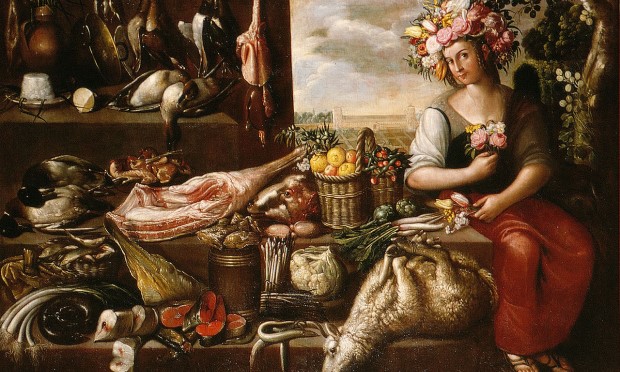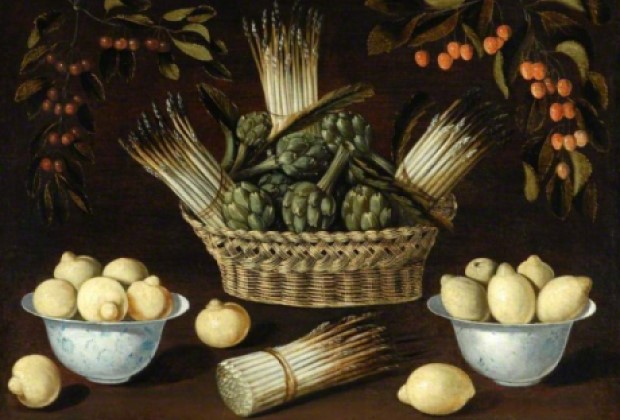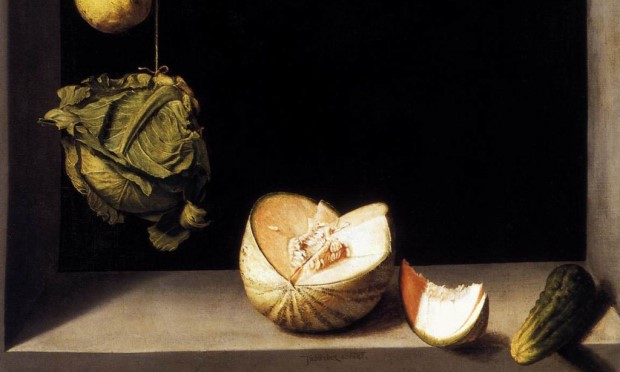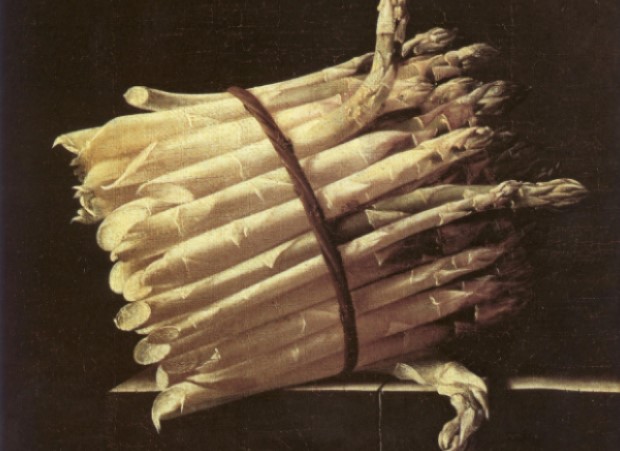From fast to feast

We have seen how springtime rituals and ceremonies almost always involve feasts.
Emerging from the harsh times at the end of winter, before the profusion of fresh things in early summer, we rejoiced in what we could get, and after a ritual fast, as much necessity as doctrine, we had license to enjoy what we could when we could, often young animals that the farmer or herdsman could not afford to rear.
Hence the porchetta, the whole roast sucking pig sold from stalls all over Italy, today an expensive delicacy, but in the past a way of disposing of surplus baby animals.
The animals in the above painting by Francisco Barrera in 1638, showing the spring months of March, April and May, show this uncomfortable reality alongside the dimpled maiden wreathed in spring flowers and the delicate young vegetables.
The tethered sacrificial lamb gazes away from the slaughtered sheep, fully aware of its own fate. We can see them as items in the larder or as potent symbols if sacrifice and redemption.
On the left are salted and smoked fish from the winter stores, alongside fresh salmon and hake, and as we move from early to late spring come wild and cultivated asparagus, artichokes, cherries and the last of the citrus fruit along with the first olives and grapes, radishes and the massive cauliflower we shall collide with next month.
We don’t know if these paintings by Barrera of the Months of the Year or the Four Seasons are an exact indication of the provisions cooked in Madrid in the 1660s, or if they are following the taste of patrons who, impressed by the work of Beuckelaer on the Low Countries or Vincenzo Campi in Lombardy (which have appeared in several Citizen columns), were happy to hang on their walls these idealised market scenes with hothouse grapes rubbing shoulders with winter’s parsnips and the early asparagus of springtime.

These picturesque displays of exquisitely rendered fashionable fruit and veg need not be taken as accurate renderings of what you could buy in local markets.
Vicky Hayward, food writer and translator of New Art of Cookery, a Spanish friar’s kitchen notebook, published by Juan Altamiras in 1745, is very wary of using these still life or genre scenes to illustrate the collection of recipes she worked on for years, which are based on the kitchen gardens and local produce of La Almunia in southwestern Aragon.
Altamiras was the pen-name of Raimundo Gómez, a Franciscan friar, who lived and cooked in this small town, and in the friary’s summer retreat in San Cristóbal.
His mendicant order, dedicated to the relief of poverty by means of preaching and good works in the community, needed its brothers to be fit and eloquent, and our Altamiras certainly was that, getting up before daylight to light the kitchen fires and put cauldrons of water to boil, attending the communal acts of worship, then dropping down the hill to the local market, or a stint in the kitchen gardens, and toiling up again withaload of vegetables and provisions for the day’s needs.

Meat and fish were part of the nourishing diet, except for fast days, but used frugally by Altamiras. It would not do to illustrate his text with Barrera’s afluent displays in far away Madrid, or the austere still lifes of Sanchez Cotán in Seville, who joined an enclosed Carthusian order which followed a pure vegan diet, and the domestic still lifes of Luis Meléndez in the 1770s told of the shopping and cooking of an urban housewife in Madrid, notabusy Franciscan friar in remote Aragon, feeding his brothers and his flock with the resources of a rural kitchen garden.
The paradox here is that while many of the recipes and ingredients were specific to a particular place, Altamiras’s book became a bestseller in Spain for generations.
Franciscans travelled a lot, so Altamiras lived and worked in different friaries, he was well read, in contemporary literature as well as cookery texts, and experienced a variety of cuisines and ingredients, not a sheltered life, but one open to influences from all over, but with a healthy mistrust of posh cookery and vainglorious chefs.
He wrote with a kindly conversational tone, and robust sense of humour. This was all about the food of ordinary folk using everyday ingredients in basic kitchens, not the French-influenced fine dining of the aristocracy. His food was nourishing and robust, but with a flair that made even the simplest recipe a success.

Very few cooks have this gift, that wafts the ordinary into the sublime. We have some in Hackney; it takes a touch of magic to make the rather dreary ‘egg and onion’ of traditional Jewish food into the voluptuous mixture conjured up by Monty’s Deli, or the ‘black dahl’ of Dishoom in Shoreditch, with its dense but not obtrusive spicing and buttery richness, and the spinach and cheese flatbread of the Akdeniz bakery, the spinach softened in its own moisture, with a subliminal hint of chilli and garlic.
Vicky’s version of Altamiras’s recipes conveys something of the special touch he brought to everything he cooked. You can find them online at newartofcookery.com and discover the background to this beautifully researched book which in Spain has now become a best-seller all over again. Asparagus cooks quickly, as the Emperor Augustus knew when he boasted smugly of concluding a tricky treaty ‘velocius quam asparagi coquantur’, as fast as cooking asparagus.
The tipping point between too crunchy and sadly soggy is critical with asparagus, so it helps to cook the spears in a very little water, and add some butter near the end, so that it wallows in its own juices, helped out with some freshly grated parmesan, or more butter andasqueeze of lemon.
Asparagus in 17th and 18th century Spain and Italy was not like the plump pale stems cultivated in the Low Countries.
Altamiras cooked and grew those with thin dark stems and more acute bitter taste, like the wild asparagus often found in country markets in Italy. Altamiras used young asparagus, chard and spinach in a strictly nonmeat broth, which makes a light intense green soup in summer, or, thickened with beaten eggs, breadrcrumbs and pounded hazelnuts, a dense winter soup.
In another recipe he gently cooks the tender tips, cut into bite-sized lengths, in olive oil, and when almost done, stirs in some beaten eggs, seasoned with a little saffron, cinnamon and cloves.
The spices might seem excessive, but Citizens who have had Ras el Hanout in their larders for generations can join forces with those of us who recently bought the stuff in our local supermarket and add a small pinch to the mixture, enough to enhance the taste without intruding on the flavour of the asparagus.
When Giacomo Castelvetro reminded us, in the early seventeenth century, of the flourishing aparagus crops of Northern Italy, coming into Venice by the boatload, he was perhaps unaware of the market gardeners of Hackney and Fulham, happy to meet our enthusiasm for expensive delicacies.
We enjoyed the thin sprew, and the forced version, all fat and pale and tender, bathed in a buttery golden light in Adriaen Coorte’s many versions of a binch of asparagus, liberated from the heavy load of symbolism of earlier market scenes, cheerful hedonism replacing smug moralising.
Apart from eating it boiled, wallowing in butter, asparagus is lovely rolled in olive oil and salt, and roasted in the oven, or grilled and serves charred in parts, but nice and soft inside, with plenty of Parmesan, or stewed in a broth made from the woody stems and chicken bones, or eaten raw with salt and olive oil.
